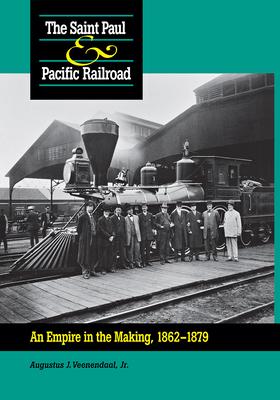Beginning in 1862 as a small carrier connecting St. Paul and Minneapolis with outlying towns, the Saint Paul & Pacific Railroad became the foundation of the vast rail system that would open the entire Northwest. As a pioneering line in virgin territory, it played a vital role in the early development of Minnesota's economy. When railroad tycoon James J. Hill took over the troubled company in 1879, its tracks were extended into westward lines that eventually, as the Great Northern Railway, reached the Pacific Ocean.
Written by leading railroad historian Augustus J. Veenendaal Jr. this finely researched book examines the growth of the fledgling Saint Paul & Pacific as it struggled to lay track, meet the schedule, and make the payroll. The railway's leaders and workers took risks of injury and ruin during these years on the frontier, when everything except hardship was in short supply. Veenendaal devotes an entire chapter to the accidents and disasters that befell the new enterprise, including deadly collisions and derailments. He also chronicles triumphs, such as the use of the Miller coupler and the refurbishment of the famed Wm. Crooks, a 4-4-0 woodburning engine that was the first locomotive in Minnesota.
Veenendaal reveals the strategic importance of foreign investment in American railroads--in particular, Dutch investment. The Saint Paul & Pacific was one of the first railroads to attract the attention of Dutch bankers, who would eventually become the second largest group of foreign investors in American railroads. After James J. Hill bought out the Dutch interest in the railroad, he reorganized it as the St. Paul, Minneapolis & Manitoba Railroad. Today, after the megamergers of recent years, the Burlington Northern Santa Fe system owns the ghost of the old Saint Paul & Pacific Railroad Company.

Saint Paul & Pacific Railroad: An Empire in the Making, 1862-1879
Beginning in 1862 as a small carrier connecting St. Paul and Minneapolis with outlying towns, the Saint Paul & Pacific Railroad became the foundation of the vast rail system that would open the entire Northwest. As a pioneering line in virgin territory, it played a vital role in the early development of Minnesota's economy. When railroad tycoon James J. Hill took over the troubled company in 1879, its tracks were extended into westward lines that eventually, as the Great Northern Railway, reached the Pacific Ocean.
Written by leading railroad historian Augustus J. Veenendaal Jr. this finely researched book examines the growth of the fledgling Saint Paul & Pacific as it struggled to lay track, meet the schedule, and make the payroll. The railway's leaders and workers took risks of injury and ruin during these years on the frontier, when everything except hardship was in short supply. Veenendaal devotes an entire chapter to the accidents and disasters that befell the new enterprise, including deadly collisions and derailments. He also chronicles triumphs, such as the use of the Miller coupler and the refurbishment of the famed Wm. Crooks, a 4-4-0 woodburning engine that was the first locomotive in Minnesota.
Veenendaal reveals the strategic importance of foreign investment in American railroads--in particular, Dutch investment. The Saint Paul & Pacific was one of the first railroads to attract the attention of Dutch bankers, who would eventually become the second largest group of foreign investors in American railroads. After James J. Hill bought out the Dutch interest in the railroad, he reorganized it as the St. Paul, Minneapolis & Manitoba Railroad. Today, after the megamergers of recent years, the Burlington Northern Santa Fe system owns the ghost of the old Saint Paul & Pacific Railroad Company.